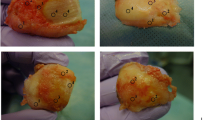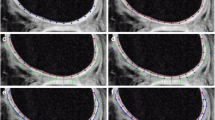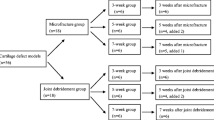Abstract
Objectives
The purpose of this study was to characterize the collagen component of repair tissue (RT) of the talus after autologous matrix-induced chondrogenesis (AMIC) using quantitative T2 and diffusion-weighted imaging.
Methods
Mean T2 values and diffusion coefficients of AMIC-RT and normal cartilage of the talus of 25 patients with posttraumatic osteochondral lesions and AMIC repair were compared in a cross-sectional design using partially spoiled steady-state free precession (pSSFP) for T2 quantification, and diffusion-weighted double-echo steady-state (dwDESS) for diffusion measurement. RT and cartilage were graded with modified Noyes and MOCART scores on morphological sequences. An association between follow-up interval and quantitative MRI measures was assessed using multivariate regression, after stratifying the cohort according to time interval between surgery and MRI.
Results
Mean T2 of the AMIC-RT and cartilage were 43.1 ms and 39.1 ms, respectively (p = 0.26). Mean diffusivity of the RT (1.76 μm2/ms) was significantly higher compared to normal cartilage (1.46 μm2/ms) (p = 0.0092). No correlation was found between morphological and quantitative parameters. RT diffusivity was lowest in the subgroup with follow-up >28 months (p = 0.027).
Conclusions
Compared to T2-mapping, dwDESS demonstrated greater sensitivity in detecting differences in the collagen matrix between AMIC-RT and cartilage. Decreased diffusivity in patients with longer follow-up times may indicate an increased matrix organization of RT.
Key Points
• MRI is used to assess morphology of the repair tissue during follow-up.
• Quantitative MRI allows an estimation of biochemical properties of the repair tissue.
• Differences between repair tissue and cartilage were more significant with dwDESS than T2 mapping.




Similar content being viewed by others
References
O'Loughlin PF, Heyworth BE, Kennedy JG (2010) Current concepts in the diagnosis and treatment of osteochondral lesions of the ankle. Am J Sports Med 38:392–404
Brittberg M (2008) Autologous chondrocyte implantation–technique and long-term follow-up. Injury 39(Suppl 1):S40–S49
Benthien JP, Behrens P (2011) The treatment of chondral and osteochondral defects of the knee with autologous matrix-induced chondrogenesis (AMIC): method description and recent developments. Knee Surg Sports Traumatol Arthrosc 19:1316–1319
Wiewiorski M, Leumann A, Buettner O, Pagenstert G et al (2011) Autologous matrix-induced chondrogenesis aided reconstruction of a large focal osteochondral lesion of the talus. Arch Orthop Trauma Surg 131:293–296
Gille J, Schuseil E, Wimmer J, Gellissen J et al (2010) Mid-term results of Autologous Matrix-Induced Chondrogenesis for treatment of focal cartilage defects in the knee. Knee Surg Sports Traumatol Arthrosc 18:1456–1464
Gille J, Meisner U, Ehlers EM, Müller A et al (2005) Migration pattern, morphology and viability of cells suspended in or sealed with fibrin glue: a histomorphologic study. Tissue Cell 37:339–348
Breinan HA, Martin SD, Hsu HP, Spector M (2000) Healing of canine articular cartilage defects treated with microfracture, a type-II collagen matrix, or cultured autologous chondrocytes. J Orthop Res 18:781–789
David-Vaudey E, Ghosh S, Ries M, Majumdar S (2004) T2 relaxation time measurements in osteoarthritis. Magn Reson Imaging 22:673–682
Borthakur A, Shapiro EM, Beers J, Kudchodkar S et al (2000) Sensitivity of MRI to proteoglycan depletion in cartilage: comparison of sodium and proton MRI. Osteoarthritis Cartilage 8:288–293
Mlynárik V, Trattnig S, Huber M, Zembsch A, Imhof H (1999) The role of relaxation times in monitoring proteoglycan depletion in articular cartilage. J Magn Reson Imaging 10:497–502
Dunn TC, Lu Y, Jin H, Ries MD, Majumdar S (2004) T2 relaxation time of cartilage at MR imaging: comparison with severity of knee osteoarthritis. Radiology 232:592–598
Stahl R, Blumenkrantz G, Carballido-Gamio J, Zhao S et al (2007) MRI-derived T2 relaxation times and cartilage morphometry of the tibio-femoral joint in subjects with and without osteoarthritis during a 1-year follow-up. Osteoarthritis Cartilage 15:1225–1234
Li X, Benjamin Ma C, Link TM, Castillo DD et al (2007) In vivo T(1rho) and T(2) mapping of articular cartilage in osteoarthritis of the knee using 3 T MRI. Osteoarthritis Cartilage 15:789–797
Blumenkrantz G, Lindsey CT, Dunn TC, Jin H et al (2004) A pilot, two-year longitudinal study of the interrelationship between trabecular bone and articular cartilage in the osteoarthritic knee. Osteoarthritis Cartilage 12:997–1005
Domayer SE, Kutscha-Lissberg F, Welsch G, Dorotka R et al (2008) T2 mapping in the knee after microfracture at 3.0 T: correlation of global T2 values and clinical outcome—preliminary results. Osteoarthritis Cartilage 16:903–908
Welsch GH, Mamisch TC, Domayer SE, Dorotka R et al (2008) Cartilage T2 assessment at 3-T MR imaging: in vivo differentiation of normal hyaline cartilage from reparative tissue after two cartilage repair procedures—initial experience. Radiology 247:154–161
Pearle AD, Warren RF, Rodeo SA (2005) Basic science of articular cartilage and osteoarthritis. Clin Sports Med 24:1–12
He B, Wu JP, Kirk TB, Carrino JA et al (2014) High-resolution measurements of the multilayer ultra-structure of articular cartilage and their translational potential. Arthritis Res Ther 16:205
Miller KL, Hargreaves BA, Gold GE, Pauly JM (2004) Steady-state diffusion-weighted imaging of in vivo knee cartilage. Magn Reson Med 51:394–398
Burstein D, Gray ML, Hartman AL, Gipe R, Foy BD (1993) Diffusion of small solutes in cartilage as measured by nuclear magnetic resonance (NMR) spectroscopy and imaging. J Orthop Res 11:465–478
Mlynárik V, Sulzbacher I, Bittšanský M, Fuiko R, Trattnig S (2003) Investigation of apparent diffusion constant as an indicator of early degenerative disease in articular cartilage. J Magn Reson Imaging 17:440–444
Friedrich KM, Mamisch TC, Plank C, Langs G et al (2010) Diffusion-weighted imaging for the follow-up of patients after matrix-associated autologous chondrocyte transplantation. Eur J Radiol 73:622–628
Bieri O, Scheffler K, Welsch GH, Trattnig S et al (2011) Quantitative mapping of T2 using partial spoiling. Magn Reson Med 66:410–418
Bieri O, Ganter C, Scheffler K (2012) Quantitative in vivo diffusion imaging of cartilage using double echo steady-state free precession. Magn Reson Med 68:720–729
Marlovits S, Striessnig G, Resinger CT, Aldrian SM et al (2004) Definition of pertinent parameters for the evaluation of articular cartilage repair tissue with high-resolution magnetic resonance imaging. Eur J Radiol 52:310–319
Duc SR, Pfirrmann CW, Koch PP, Zanetti M, Hodler J (2008) Internal knee derangement assessed with 3-minute three-dimensional isovoxel true FISP MR sequence: preliminary study. Radiology 246:526–535
Shepherd DE, Seedhom BB (1999) Thickness of human articular cartilage in joints of the lower limb. Ann Rheum Dis 58:27–34
Quirbach S, Trattnig S, Marlovits S, Zimmermann V et al (2009) Initial results of in vivo high-resolution morphological and biochemical cartilage imaging of patients after matrix-associated autologous chondrocyte transplantation (MACT) of the ankle. Skelet Radiol 38:751–760
Marik W, Apprich S, Welsch GH, Mamisch TC, Trattnig S (2012) Biochemical evaluation of articular cartilage in patients with osteochondrosis dissecans by means of quantitative T2- and T2-mapping at 3 T MRI: a feasibility study. Eur J Radiol 81:923–927
Apprich S, Trattnig S, Welsch GH, Noebauer-Huhmann IM et al (2012) Assessment of articular cartilage repair tissue after matrix-associated autologous chondrocyte transplantation or the microfracture technique in the ankle joint using diffusion-weighted imaging at 3 Tesla. Osteoarthritis Cartilage 20:703–711
Zheng MH, Willers C, Kirilak L, Yates P et al (2007) Matrix-induced autologous chondrocyte implantation (MACI): biological and histological assessment. Tissue Eng 13:737–746
Knutsen G, Engebretsen L, Ludvigsen TC, Drogset JO et al (2004) Autologous chondrocyte implantation compared with microfracture in the knee. A randomized trial. J Bone Joint Surg Am 86-A:455–464
Acknowledgments
The scientific guarantor of this publication is Dr. Ueli Studler. The authors of this manuscript declare no relationships with any companies whose products or services may be related to the subject matter of the article. The authors state that this work has not received any funding. No complex statistical methods were necessary for this paper. Institutional Review Board approval was obtained. Written informed consent was obtained from all subjects (patients) in this study. Written informed consent was waived by the Institutional Review Board. Some study subjects or cohorts have been previously reported in Delayed gadolinium-enhanced MRI of cartilage of the ankle joint: Results after autologous matrix-induced chondrogenesis (AMIC)-aided reconstruction of osteochondral lesions of the talus. Wiewiorski et al. Clinical Radiology 6/2013. Methodology: prospective, observational, performed at one institution.
Author information
Authors and Affiliations
Corresponding author
Rights and permissions
About this article
Cite this article
Kretzschmar, M., Bieri, O., Miska, M. et al. Characterization of the collagen component of cartilage repair tissue of the talus with quantitative MRI: comparison of T2 relaxation time measurements with a diffusion-weighted double-echo steady-state sequence (dwDESS). Eur Radiol 25, 980–986 (2015). https://doi.org/10.1007/s00330-014-3490-5
Received:
Revised:
Accepted:
Published:
Issue Date:
DOI: https://doi.org/10.1007/s00330-014-3490-5




